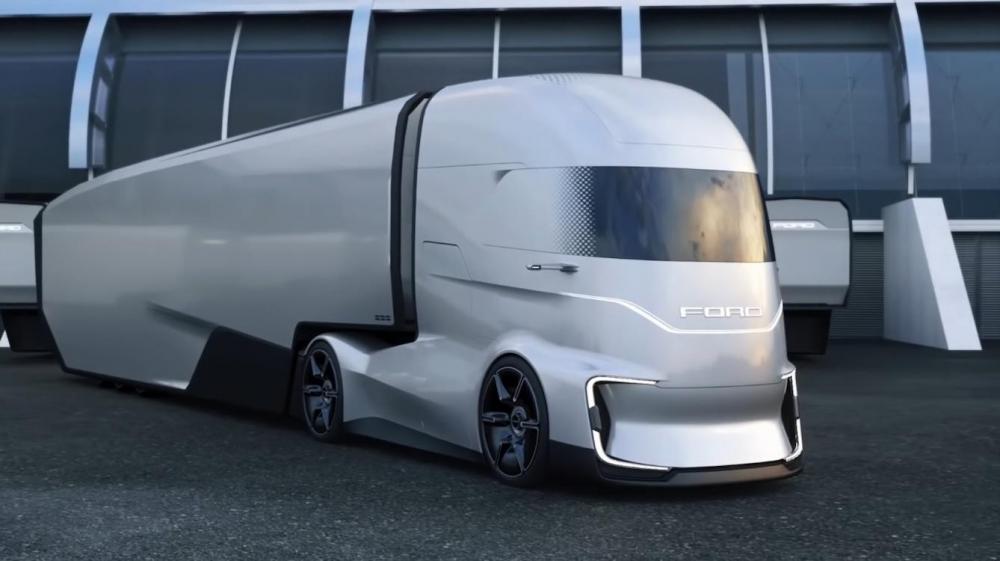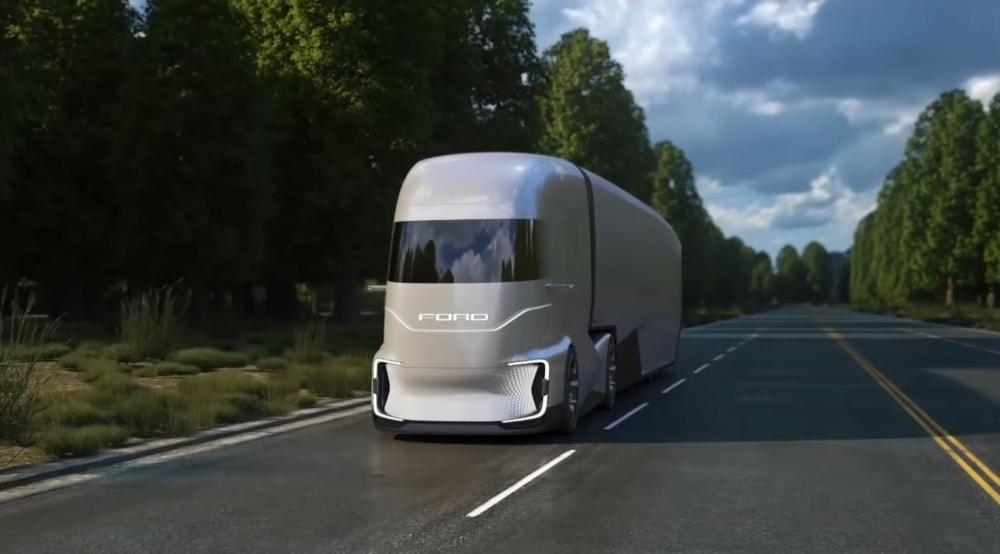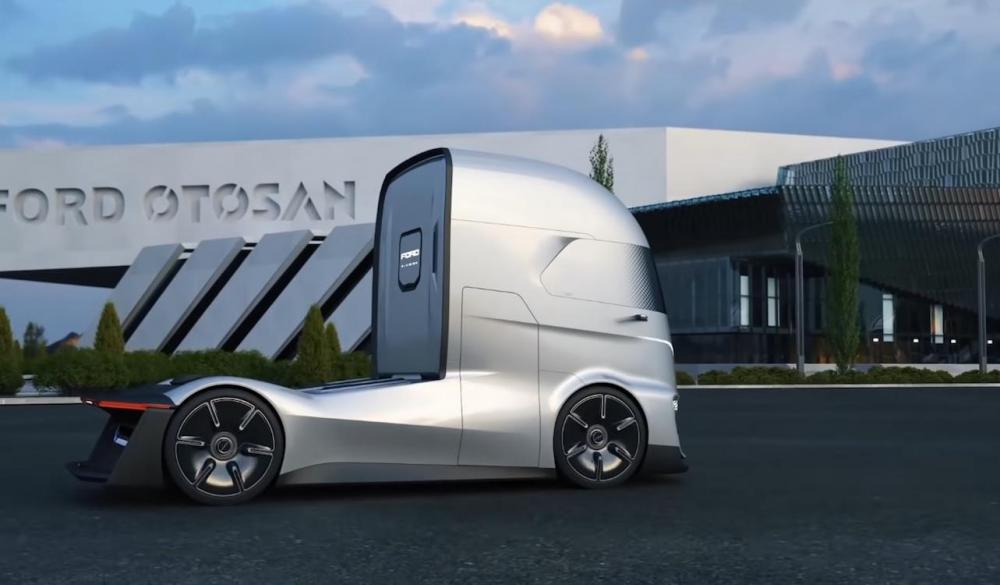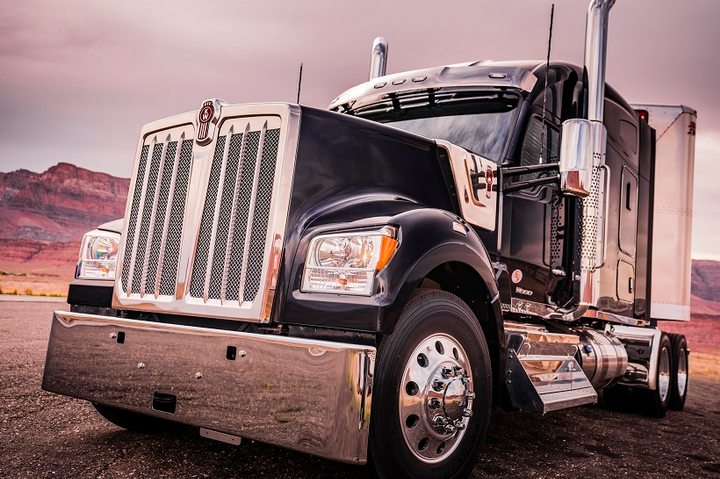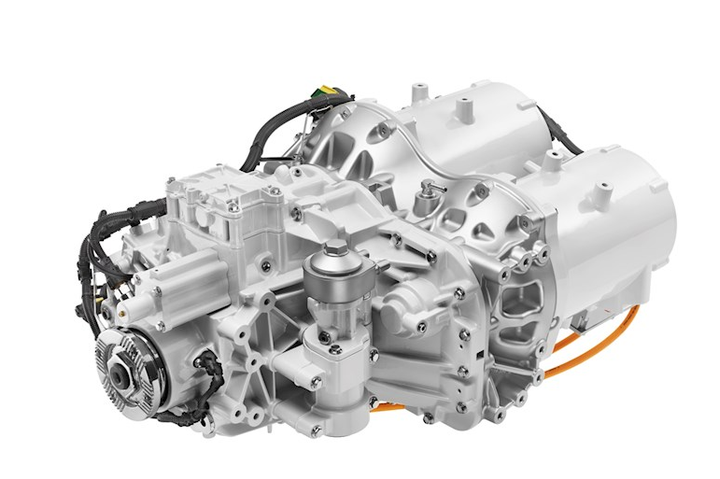
kscarbel2
Moderator-
Posts
18,886 -
Joined
-
Days Won
114
Content Type
Profiles
Forums
Gallery
Events
Blogs
BMT Wiki
Collections
Store
Everything posted by kscarbel2
-
"People should and do trust me" - Hillary Clinton
kscarbel2 replied to kscarbel2's topic in Odds and Ends
-
The 8MY324 R-model shifter boot mounts on top of the floor pan with a rectangular metal retainer atop it.
-
No special promotion. The Mack Shop sold many items like this from the time of the Hansen era, at his request. He made the bulldog a symbol of the company, a symbol of America, that we could all be proud of.
-
Michael Strong, The Detroit Bureau / September 28, 2018 Does Tesla have another competitor in the battery-electric semi truck arena? Maybe. Ford Motor Co. took the wraps off an electric semi truck concept called the F-Vision at the 2018 IAA Commercial Vehicles expo in Hanover, Germany. The company’s vision is similar in many ways to Tesla’s offering with a high level of autonomy and a sleek exterior design. However, it would appear that Elon Musk and the gang in Palo Alto can breathe easier – at least about this anyway – as Ford says the new F-Vision is only a concept. Unlike auto shows, generally when a maker says something is a concept, there is some lag time between denial (i.e. “It’s just a concept”) to voila! (i.e. “You can put your deposit down now”). Obviously, Tesla is the biggest exception to that “rule.” The F-Vision concept is Ford Trucks’ vision on electrification, autonomous and connected drive, lightweight and zero carbon emission products. It cares about humans’ priorities both inside the cab and on the road, as well as the load being carried, and aims constantly to connect with the environment and users and communicates, the company notes. Ford's global design and engineering center for heavy trucks and engines, Ford-Otosan in Turkey, created the F-Vision concept. Not only is the exterior futuristic looking, but the actual vehicle possesses some features one might not expect. Of course, it’s autonomous and can link automatically with its trailer. It can convoy with other vehicles. However, if also features cameras in place of side mirrors, and an automatically tinting windshield. It’s said to be capable of automatically linking with its trailer, as well as operating in a linked-together convoy mode. If Ford does bring it to market, it’ll not only have the aforementioned Tesla truck to contend with, but also Volvo. The Swedish truckmaker is working furiously on its Vera electric semi concept. The truck has no cab at all because it’s entirely autonomous. Additionally, other companies in the segment, like Freightliner and Cummins, aren’t just sitting idly by. Ford may also need to inspect its new F-Vision closely to ensure it’s not too much like Nikola Motors entry into the segment. Nikola sued Tesla earlier this year and could be awarded up to $2 billion in damages if it finds in favor of the company’s suit. Nikola’s case, however, isn’t looking too good. Recently, the United States Patent and Trademark Office found that the two designs differ enough to award separate patents. If Nikola fails to win in court against the troubled Tesla, its odds of successfully suing Ford would be even smaller still. .
-
Yes. I used to have a cupboard full.
-
Ford Launches F-Max Tractor for Global Markets
kscarbel2 replied to kscarbel2's topic in Trucking News
The "P" lever is parking brake control. Not all (global) trucks have a trolley brake lever. I still like it, but with today's advanced electronic braking systems, there less need for it. From the superb chassis "packaging" to the lower center instrument panel with two large pull-out drawers, the F-MAX is an impressively engineered truck. -
DAF Trucks Showcases Hybrid, Full-Electric Models at IAA
kscarbel2 replied to kscarbel2's topic in Trucking News
A photo gallery of the DAF exhibit at IAA 2018. https://product.360che.com/photoexpc_big/260560.html -
A photo gallery of the BMC "Tugra" launch at IAA 2018. https://product.360che.com/photoexpc_big/260462.html
-
Ford Launches F-Max Tractor for Global Markets
kscarbel2 replied to kscarbel2's topic in Trucking News
A great photo gallery of the new Ford F-Max launch at IAA 2018 (81 photos). https://product.360che.com/photoexpc_big/262129.html -
Kenworth to replace W900 with new W990 in 2020
kscarbel2 replied to kscarbel2's topic in Trucking News
Kenworth Trucks Australia certainly doesn't peddle any tacky rubbish like this. -
Kenworth to replace W900 with new W990 in 2020
kscarbel2 replied to kscarbel2's topic in Trucking News
Kenworth Launches Long-Hood Conventional W990 John G. Smith, Heavy Duty Truckling (HDT) / September 28, 2018 Kenworth’s W900 has become a staple of the show ‘n shine circuit, its long hood and gleaming accents seem to guide drivers down the highway. The look has had a starring role in movies and been immortalized in belt buckles. Now it has been re-imagined in the form of the W990. “We’re celebrating the legacy of the W900 and the introduction of the next generation,” said Kenworth general manager and Paccar vice-president Mike Dozier, during a customer launch party at the Las Vegas Motor Speedway. “A lot of passion, a lot of pride, have gone into what we think is a really special product.” The W900L remains available, he stressed. “But we’re planning for the future.” Redefining a model like this is no small matter. The W900 has, in one form or another, been a staple of Kenworth’s lineup since 1961. The W is even a nod to Edgar K. Worthington, one of the company’s founding fathers who gave the brand its "worth." “Redesigning an icon is a once-in-a-lifetime opportunity for a design team,” added Jonathan Duncan, Kenworth design director. Trucks like Kenworth’s T680 on-highway tractor and medium-duty models are important, he said. But they’re different. “They don’t sing songs about those. They don’t put those trucks on belt buckles necessarily.” The Las Vegas event was the first opportunity most people outside of the Paccar family have had to soak in the truck’s unique profile. Marketing teams have been keeping the truck under wraps for months, shrouding the distinct hood as it moved to photo and video shoots. “The driver’s view over the hood, that’s a huge part of the appeal,” Duncan said. “It’s really designed to accentuate the hood … All this creates kind of an emotional connection to the driver.” Specifications Measuring 131.5 inches from the bumper to the back of the cab – 1.5 inches longer than the W900L — the W990 comes as a day cab, with a 40-inch flat top sleeper, and 52- and 76-inch mid-roof sleepers. It also comes standard with a proprietary Paccar powertrain with a 510-hp/1,850 lb-ft MX-13 engine, 12-speed automated transmission, and 40K tandem rear axles. It’s all built on the same cab platform used in the T680 and T880. Sitting up front is the largest cooling module found on any of Kenworth’s on-highway trucks, Duncan said. And the shape is 6-7% more aerodynamic than a W900L, although he admits that won’t likely be the main driver for most buyers. Much of the appeal will focus on the appearance. The grille at the front maintains what’s described as a “cathedral shape”, with inset surfaces to define a tailored look. The “wind-split” raised section at the top of the hood itself is meant to accentuate its length as drivers look over the dash. Stainless steel air intakes wrap over the top so they can be seen from the driver’s seat, too, and against some colors they’re said to look twice as deep as they actually are. Inside, final touches come in the form of a limited-edition cab and sleeper interior, and the W990 Driver’s Studio Package. The interior itself is black, accented by door and dash trim elements made in a glossy ravenwood. Blue accents can be found in the double-stitched diamond door pads, leather-wrapped steering wheel, and the backing for driver and passenger seats that have suede charcoal inserts and perforated leather. For living quarters, the W990 Driver’s Studio features the passenger seat that swivels 180 degrees and a rotating table for two, drawer-style refrigerator, and space for a microwave. The premium audio package includes a 320-watt amp, 10-inch subwoofer and eight speakers; swivel TV mount for up to a 28-inch flat screen TV; and optional EpicVue pre-wire for satellite TV. There’s an 1,800-watt inverter including a connection for shore power and four standard 120-volt sleeper outlets. The LED lights shine over it all. The ever-important storage amenities come in the form of a full-size wardrobe, storage drawers, and storage space under the bunk. While it offers a nod to the company’s heritage, the W990 also comes standard with the latest TruckTech+ remote diagnostics, and the seven-inch color in-cab NAV+HD display for navigation, audio controls, blind spot camera inputs and more. Paccar Parts was also involved in the process to create aftermarket enhancements like a special LED lighting package and stainless trim. “They’re going to want to customize their trucks,” Duncan said, referring to early buyers. “We’ve given them a great place to start.” The truck will visit 20 dealerships in the U.S. and Canada in October and November. . -
I had to reconsider my position on this, as it was another time and place with differing attitudes. This happened when a good woman feared telling her parents. Some parents cared more about burying it, lest neighbors, relatives and friends learn of it, to their embarrassment, than they did the daughter’s mental trauma of being raped, and heaven forbid impregnated. Am I wrong? This is all assuming she’s telling the truth. For the record, and I’ll be candid as usual, I don’t care for most wealthy people (Mark being a rare exception), particularly if they spoil their children. I’m a public school boy with a dislike for private, prep, boys and girl’s schools.
-
Or, is this but one of an ongoing line of distractions targeted at the massed designed to lure their attention away from other matters? "Distract the masses" is one of the oldest plays in the Book of Government. And governments around the world have got it down to a science. Remember that classic movie line, "pay no attention to the man behind the curtain".
-
I don't have a Facebook or Twitter account. There are far more ways to productively utilize my time. Sharing your life on social media would have to take up most of one's time. I suppose focusing their mind on an actual job is out of the question.
-
I remember most events in my life from 36 years ago, the major points, but I certainly don't remember every detail.
-
I think Piers Morgan nailed it............ ----------------------------------------------------------------------------------------------------------------- These are the words I originally wrote after Christine Blasey Ford finished testifying to the US Senate today: ‘I believe her. It’s as simple as that. For four hours, I watched Christine Blasey Ford testify to the US Senate and I found her to be an extraordinarily powerful, compelling and credible witness with regard to the sexual abuse she claims to have suffered at the hands of Supreme Court nominee Brett Kavanaugh. I was not alone. Twitter blew up with people from all sides of the political and social spectrum saying THEY believed her too. TV news anchors from CNN to Fox queued up to say they found Ford extremely convincing. And thus I imagine the vast majority of the tens of millions of Americans watching agog from their homes believed her as well. Because the bottom line is that she was cool, calm, collected, and utterly believable. Her tears, when they came, felt real. Her testimony felt real. SHE felt real. I stopped writing when Brett Kavanaugh walked in to begin his testimony, but this, I felt certain, would be the theme of this column. There was nothing Kavanaugh could surely say or do that could possibly alter this impression? I was wrong. Kavanaugh’s performance was one of the most stunning, raw, breath-taking displays of raw, raging fury that I have ever seen on live television. He was surging with passion and indignant anger, and emotion; SO much emotion. He cried, he sighed, he sniffed, he snorted. And he ranted. This was a man right on the edge, exploding before our very eyes at what he perceived to be the horrific injustice of what has befallen him. Kavanaugh’s not just any man. He’s one of America’s most experienced, respected judges; so a man who until two weeks ago, was considered to be someone of total integrity, someone beyond reproach. And by the time he’d finished, I believed him too. His tears, when they came, felt real. His testimony felt real. HE felt real. But they can’t both be telling the truth, can they? The bottom line is I don’t now know whom to believe, and I defy anyone else to either. Ford and Kavanaugh were both equally convincing. They both came over as decent, civilised, eloquent people. They both were inherently believable. The facts of this case remain unsubstantiated, disputed and debatable. It comes down to whom you believe most, and I just don’t know the answer to that question. Who can say, honestly and with any certainty, where the truth lies? I can’t, can you? What I can say though is that this was one of the most disgusting, disgraceful things I have ever witnessed. For these two previously unknown people to be dragged through such a revolting public court of gladiatorial barbarism for the delectation of a mass TV audience was painful, so painful I could barely watch at times. Yet it was an absolutely inevitable consequence of the way Washington has spiralled in recent years into a vile cesspit of extreme partisan bullsh*t – fuelled by rampant, vicious social media. Today was a dark, tragic day for America. It was a day when the whole country, and indeed much of the rest of the world, tuned in to see two people tortured and humiliated. I get that Supreme Court nominees have to be vigorously vetted, and have to be held to a different standard of behaviour to the rest of us. Brett Kavanaugh could be sitting on that court for 30-40 years, making the most important decisions in American law that could have far-reaching effects on the lives of 320 million people. He HAS to be a man of unimpeachable character. So yes, he has to be investigated. And it’s perfectly right and proper that if a woman like Christine Blasey Ford believes she was sexually assaulted by Kavanaugh when she was just 15 years old, then her allegations should be thoroughly examined. As should any other serious allegations. But what we watched today was nothing short of a circus - a long, disturbing, wretched circus; a circus watched by a baying global mob, most of whom decided long before the hearings began whom they believed. Kavanaugh looked unhinged today – perhaps too unhinged to ever sit on the Supreme Court - but if I’d been falsely accused of the stuff he’s been accused of in the past fortnight, I’d probably be pretty damn unhinged too. He was fighting not just for a place on the Supreme Court, but for his reputation, his dignity, his family. To see his loyal wife silently weeping throughout his testimony was agonising. She knows that everything her husband has worked for in his entire life is now imperilled. Every security she took for granted about their family life is now threatened. If Kavanaugh is guilty, then he deserves to be duly punished. But what if he’s innocent? What if Ms Ford, who was just a young teenage kid at the time, has got the wrong guy? I don’t think she’s a liar, but maybe she made an honest mistake. How do we know for sure? How will we EVER know? Where are the cold hard FACTS? There aren’t any, there can’t possibly be any after 35 years. What we’re left with is a stinking, horrible mess. Many feel America has never felt so bitterly divided, and this ugly farce today will just pour fuel onto that blazing partisan fire. I saw people on Twitter gleefully tearing both Ford and Kavanaugh to pieces all day long, all doing so from a politically partisan perspective. If the situation was reversed, and Kavanaugh was a Democrat nominee, then all those screaming blue murder against him would be screaming in support of him, and all those currently supporting Ford would turn on her like two-faced rattlesnakes. It’s not about any attempt at fair justice. It’s about politics. The Democrats, led by Senator Dianne Feinstein, timed this bombshell to cause maximum damage to the nomination process, and to exploit the inevitable scandalous headlines to influence the vital midterm elections in just 40 days time. Feinstein knew about Ford’s allegation two months ago. The right thing to do would have been to publicly demand an immediate investigation – including, if necessary, by the FBI. Instead, she held it back, waiting to strike when the potential political gain was at its most timely. In doing so, she behaved in exactly the same reprehensibly partisan self-serving manner that Republicans have behaved over previous Democrat Supreme Court nominations. But that makes her just as bad as them. Shame on Senator Feinstein, shame on the Democrats. That such an important moment in American history should be reduced to this horrific bear-pit is as absurd as it’s unacceptable. Every American who genuinely cares about their country should share my outrage about what they watched today. At one stage, Kavanaugh was actually grilled about flatulence - in the United States Senate by a serving United States senator. Think about that for a moment. The whole thing was a complete and utter disgrace. Or as Senator Lindsey Graham put it today: ‘The most despicable thing I have ever seen in politics.’
-
The news reports I've read have reflected a consistent story line. I have not read of anyone accusing her of changing her story. We don't know what the truth is....we weren't there. But she is convincing to me. Doesn't seem like the type to make it up. The only witness, the one other teenage boy in the room, allegedly was Mark Judge. Ford never said there were any other people in the room. I can't imagine any more evidence than what we've now seen. As for parties, with each passing day, I feel even more strongly that political parties should be banned. Bloomberg in 2020 for president? The mere thought of that is very depressing.
-
Fleet Owner / September 27, 2018 Parker Hannifin Corporation has launched a new solution to ease the burden of changing oil in engines and machines. QuickFit is a complete oil change system that takes the complex nature of changing oil and simplifies the process with a cleaner and safer way that can be accomplished in less than 30 minutes. Traditional maintenance oil changes face a multitude of challenges including confined spaces that make access difficult and can create safety and ergonomic risks. A system’s multiple drain and fill points greatly increases the chances for cross-contamination, and by removing an oil filter that’s still full of oil can result in leaks, spills and potential environmental issues. Parker says that QuickFit alleviates these issues with a more accessible, single point of connection. Its three-step process purges, evacuates and refills oil all from the one connection point. Purge: Uses compressed air to purge the oil by pushing it through the filter into the engine sump. Evac: Oil is drained directly to waste containment, allowing for clean removal of the filter. Refill: New oil is pumped into the engine using the same connection point. “Reducing the number of steps in the process eliminates any risk of safety hazards or spills, which creates less consumable waste and is more environmentally friendly,” said Mario Calvo, division marketing manager for Parker Quick Coupling Division (QCD). “The QuickFit 3-step process also makes for a more standardized solution, which helps to lower operating costs, increases profitability and reduces oil change time by about 50 percent.” . .
-
Here they come: First North American Volvo trucks to go electric Aaron Marsh, Fleet Owner / September 27, 2018 Volvo Trucks today announced that its first North American model heavy trucks—a total of 23 of them—will get the company's all-electric drivetrains in a special demonstration project in California. The trucks are to be tested out next year and will be commercialized in 2020, Volvo said. The California Air Resources Board has preliminarily awarded $44.8 million for the project. The demonstration, dubbed Volvo LIGHTS for "Low-Impact Green Heavy Transport Solutions," is a partnership between Volvo Group, California's South Coast Air Quality Management District, and "industry leaders in transportation and electrical charging infrastructure." In that vein, Volvo also detailed that the project will involve 16 partners and will "transform freight operations at the facilities of two of the United States' top trucking fleets." Claes Nilsson, president of Volvo Trucks, said the company is "convinced that electrified truck transport will be a key driver of sustainable transports." Notably, this is not only going to include heavy truck technology—indicating Volvo and the parties involved are exploring how to work big electric trucks into the broader electric vehicle infrastructure. The Volvo LIGHTS project will work in some non-truck battery-electric equipment, non-proprietary (i.e., not Volvo-specific) chargers, and solar energy production equipment. "This is an excellent opportunity to show the end-to-end potential of electrification," said Peter Voorhoeve, president of Volvo Trucks North America. "From solar energy harvesting at our customer locations to electric vehicle uptime services to potential second uses for batteries, this project will provide invaluable experience and data for the whole value chain." Which North American Volvo trucks? What trucks will this involve? Volvo officials are not yet ready to discuss which specifically, but did release some helpful details. First, the North American trucks in this project will get the battery-electric drivetrain used in Volvo Trucks' FE Electric cabover unveiled in Europe earlier this year and slated to go on sale next year. It's the equivalent of a light Class 8 truck by U.S. standards with a gross vehicle weight (GVW) rating of about 59,525 lbs. The FE Electric has a dual electric motor capable of 496 hp. maximum/ 349 hp. continuous and 627 lbs.-ft. of torque, with up to a huge 20,652 lbs-ft. max torque at the rear axle. The electric drivetrain provides a range of up to 124 miles and can be DC fast-charged in 1.5 hours or regular low-power AC charged in about 10 hours. With the Volvo LIGHTS project, Volvo said it will deploy eight multi-configuration battery-electric Class 8 electric demonstration units capable of GVW plus 15 tons. An additional 15 precommercial and commercial units will be put to use throughout California's South Coast Air Basin, which includes Los Angeles, Orange, Riverside, and San Bernardino counties. Given the range of the electric drivetrain and the location they'll be tested, the North American trucks for the project could well come from Volvo's new VNR regional-haul lineup, for instance, rather than Volvo's bread-and-butter North American VNL Series designed for long-haul operations. Volvo further noted that the project will include a variety of technologies such as remote diagnostics, geofencing, and the company's web-based service management platform to monitor truck performance and maximize vehicle uptime. The project is estimated to eliminate 3.57 tons of air pollutants and 3,020 tons of greenhouse gases annually, according to Volvo. Separately, Volvo recently also recently showed off a fully autonomous, electric concept tractor system called Vera (see below). Read more on Volvo's philosophy and insight regarding electric trucks at www.volvotrucks.com/electromobility.
-
Volvo Trucks to Bring All-Electric Truck Here in 2020 Heavy Duty Trucking (HDT) / September 27, 2018 Volvo Trucks will demonstrate an all-electric truck in California next year with plans to bring it to market in North America in 2020. The truck is based on Volvo's existing FE Electric truck, which was developed for Europe and will go on sale there in 2019. Funding for the demo project comes from the California Air Resources Board, which has preliminarily awarded $44.8 million to the South Coast Air Quality Management District to fund a project dubbed the Volvo Low Impact Green Heavy Transport Solutions. Volvo LIGHTS will involve 16 partners and deploy eight multi-configuration, battery-electric Class 8 demonstration units to two unnamed "top trucking fleets." Volvo LIGHTS will also integrate non-truck battery electric equipment, non-proprietary chargers, and solar energy production equipment. The goal is to eliminate an estimated 3.57 tons of air pollutants and 3,020 tons of greenhouse gases annually. The project is part of California Climate Investments, a statewide initiative that aims to use cap-and-trade dollars to reduce greenhouse gas emissions, while also strengthening the state’s economy and improving public health and the environment. “This is an excellent opportunity to show the end-to-end potential of electrification,” said Peter Voorhoeve, president of Volvo Trucks North America. “From solar energy harvesting at our customer locations, to electric vehicle uptime services, to potential second uses for batteries, this project will provide invaluable experience and data for the whole value chain.” .
-
Commercial Carrier Journal (CCJ) / September 27, 2018 Volvo Trucks [North America - VTNA] announced Thursday it expects to begin all-electric truck demonstrations in California next year with commercialization to follow in 2020. The California Air Resources Board (CARB) has preliminarily awarded $44.8 million to California’s South Coast Air Quality Management District (SCAQMD) for the Volvo LIGHTS (Low Impact Green Heavy Transport Solutions) project – a partnership between the Volvo Group, SCAQMD, and industry leaders in transportation and electrical charging infrastructure. Volvo Trucks will deploy eight multi-configuration battery Class 8 electric demonstration units (GVW +15 tons), and an additional 15 precommercial and commercial units, throughout California’s South Coast Air Basin. The Volvo LIGHTS project will involve 16 partners, and transform freight operations at the facilities of two U.S. trucking fleets. Volvo LIGHTS is part of California Climate Investments, a statewide initiative that puts billions of Cap-and-Trade dollars to work reducing greenhouse gas emissions, strengthening the economy and improving public health and the environment – particularly in disadvantaged communities. “This is an excellent opportunity to show the end-to-end potential of electrification,” said Peter Voorhoeve, President of Volvo Trucks North America. “From solar energy harvesting at our customer locations, to electric vehicle uptime services, to potential second uses for batteries, this project will provide invaluable experience and data for the whole value chain.” The demonstration units will be based on the technology currently being used in the Volvo FE Electric, which Volvo Trucks presented in May and will begin selling in Europe in 2019. A variety of smart technologies will be used – including remote diagnostics, geofencing, and the company’s web-based service management platform – to monitor all truck performance aspects of the project, and maximize vehicle uptime. The project will reduce an estimated 3.57 tons of air pollutants and 3,020 tons of greenhouse gases annually.
-
2020 Ford F-150 hybrid to be built at Dearborn Truck Plant Michael Martinez, Automotive News / September 27, 2018 DETROIT — Ford Motor Co. will build the upcoming hybrid version of its F-150 pickup at its truck plant in Dearborn, Mich., company officials said Thursday. The vehicle, announced in 2015, will feature a gasoline-electric motor that can double as a mobile generator. Until now, it had been unclear whether the automaker would build the hybrid model in Dearborn or in Missouri at its Kansas City Assembly Plant, which also makes F-150s. The F-150 hybrid is due out as a 2020 model. "It's going to be a truck that takes you farther, without sacrificing power, and a truck that lets you do more when you get there, with electricity for everything, from your tools to your camping gear," Executive Chairman Bill Ford said at an event celebrating the 100th anniversary of Ford's Rouge manufacturing complex in suburban Detroit, which includes the Dearborn Truck Plant. "When it comes to building the best trucks in the world, we never rest. Whether they're gas, diesel or hybrid — or, when the time comes, fully electric — they will power the world in a sustainable way and remain built Ford tough." Workers in Dearborn produce one F-150 every 53 seconds on average. The pickup is one of 28 vehicle models that have been built at the Rouge, where Ford currently employs 7,500 workers on three shifts. "To us, it's more than a factory," Bill Ford said. "It's a source of pride for generations of workers who have built the best cars and trucks in the world. It's an all-American symbol of strength, opportunity and hope; a place where we've always been creating tomorrow together." In addition to the product news, Ford and the UAW announced Thursday that Ford has invested $35 million to upgrade a technical training center a few miles from the Rouge complex, expanding the site by 50 percent to 120,000 square feet. The automaker had agreed to the investment as part of its 2015 contract with the union.
BigMackTrucks.com
BigMackTrucks.com is a support forum for antique, classic and modern Mack Trucks! The forum is owned and maintained by Watt's Truck Center, Inc. an independent, full service Mack dealer. The forums are not affiliated with Mack Trucks, Inc.
Our Vendors and Advertisers
Thank you for your support!



